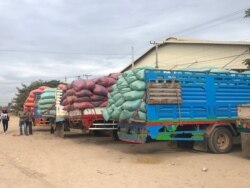Government data showed that Cambodia’s rice exports to the European Union had dropped by 30 percent in 2019, after the economic bloc imposed tariffs at the start of last year.
Ministry of Agriculture data showed that rice exports dropped from 300,000 tons in 2018 to around 200,000 tons last year. At the same time, China has increased its imports, after the country’s leaders agreed to increase rice trade to 400,000 tons a year.
The European Union imposed tariffs for three years starting January 2019, after Italy triggered protectionist measures to safeguard its rice sector. The tariffs were around $200 a ton in 2019 and will fall to $140 for the third year.
As exports to the EU have fallen, farmers said that rice dealers were using the tariffs as an excuse to lower rice prices in the market, leading to losses for farmers.
Farmers in Battambang province’s Omal commune – at the center of Cambodia’s rice production –have complained about low prices for their paddy crop last year.
Choeun Socheat, a rice farmer, said the price of paddy was surprisingly low, around just $232 per ton, around $60 lower than they were getting in the previous year.
“The dealers told us that the price is low because they are buying rice to keep at the rice mills, but not for exporting abroad,” she said.
“I don’t know whether to believe them or not. We have to sell with the price dealers set.”
Another farmer in the same commune, Kheun Pheakdey, said it was getting hard to recoup costs, especially fertilizer costs, which had gotten more expensive. He said around $267 a ton would be the very least he needs to make any earnings.
“I can’t make profit even to pay for the fertilizer costs,” he said.
Chan Sokheang, vice president of Cambodia Rice Federation, agreed that dealers were undercutting farmers on the pretext of the tariffs, but claimed the industry body could do nothing about it.
“How can we curb since it happens across the country? It is them taking advantage [of farmers],” he said.
He claimed that the cost of fragrant, or high-quality rice was still high, and that farmers should try to directly sell to millers.
However, Cambodia’s agriculture sector has long been plagued with the lack of storage facilities or cheap transportation for crops, with millers taking on these investments on an individual basis.
Theng Savoeun, the director of the NGO Coalition of Cambodian Farmer Community, said it was possible to take advantage of farmers because they had no access to market information and were disconnected from millers, allowing dealers to misinform them.
“The dealers at the lower level take this opportunity to lower the price of paddy rice,” he said. “Some dealers have networks with officials or big business people.”
Total rice exports for Cambodia in 2019 was around 620,000 tons, with the EU accounting for 32 percent of this exported rice and China for 41 percent, or around 250,000 tons.








